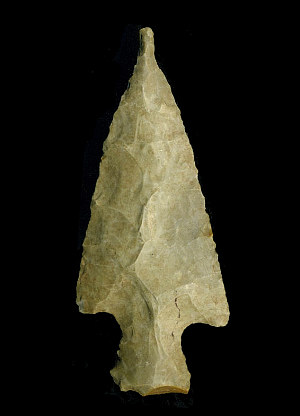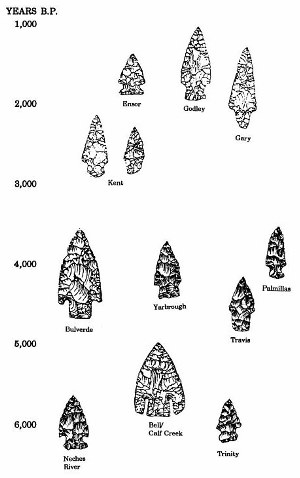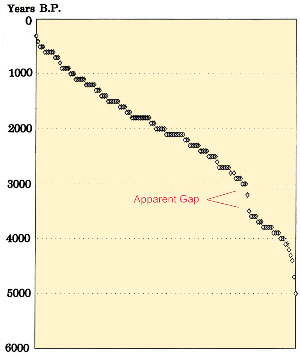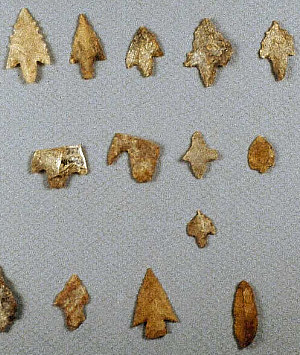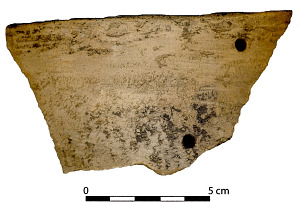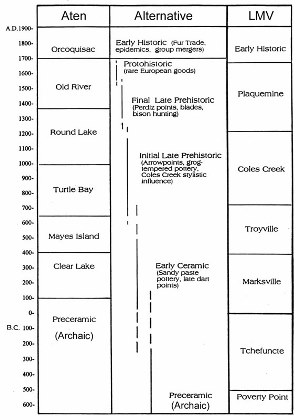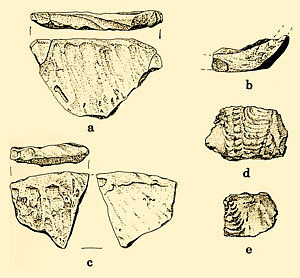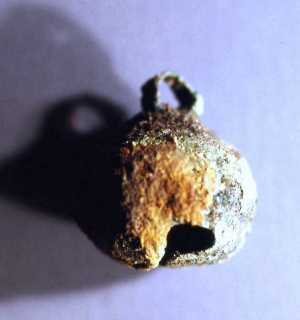Chronology
Cultural sequence of the upper Texas coast showing changes in selective traits and patterns. Adapted from Ricklis 2004, Figure 6.11. Enlarge to see full chart. |
|
People have lived in Southeast Texas since early Paleoindian times 13,000 years ago as evidenced by scattered Clovis points. Finds of these and later Paleoindian projectile point styles, such as Folsom, Plainview, San Patrice, Dalton, and Angostura points, tell us little or nothing about the use of the coastal zone. The coastline in Late Pleistocene and early Holocene times was located at least 80-100 kilometers (50-60 miles) seaward from the modern coast. A similar situation existed during the Early Archaic period, some 9,000-7,000 years ago, although rising sea level gradually (probably rising in a step-like fashion) brought the coast closer to its present location. It is not until after 5,000 years ago (3,000 B.C.) when sea level began to reach its modern still-stand level that solid archeological evidence emerges of sustained human occupation in the Galveston Bay area. This makes sense because the Galveston Bay system as we know it today was still forming five millennia ago and had yet to fully develop into a productive estuary. The earliest well-documented sites are rangia shell middens containing Middle and Late Archaic dart points that have been radiocarbon dated to between 5,000-3,500 years ago. These occur along drainages just inland from Galveston Bay. For instance, site 41GV53 is situated near present-day League City along Clear Creek, a sizeable stream that drains into the east shore of Galveston Bay. One of the best documented stratified Archaic site is Eagle Ridge (41CH252) which overlooks the delta of the Trinity River. Archeological data from that site suggests that deer played a far more important dietary role in the Middle and Late Archaic than did fish and shellfish. By the end of the Late Archaic period, between about 3,000 to 2000 years ago, there is abundant evidence for human occupation of the Galveston Bay area. Sea level stabilized at the modern level about 3,000 years ago and the Galveston Bay estuary system was fully formed. Most documented archeological sites contain rangia shell middens and nearly all occur along the shores of the secondary bays and the lower stretches of the streams and rivers that empty into the bays. It is clear that local populations were growing and that native peoples were making increased use of estuary resources, especially shellfish and fin fish. By definition the Archaic (or “Preceramic”) era in Galveston Bay area is said to end with the introduction of ceramics by 2,000 years ago (probably several hundred years earlier). Ceramic technology appears to have spread westward into the area from Louisiana and the Lower Mississippi Valley. Early pottery along the Upper Texas coast consists of thick-walled vessels very similar to Tchefuncte pottery found in Louisiana. Within a few centuries the Galveston Bay area pottery was dominated by a locally made sandy-paste ware known as Goose Creek, a tradition that persisted right up until early historic times. Grog and bone-tempered pottery vessels were also made locally during the latter half of the Ceramic period, which is also known as the Late Prehistoric period. During the long-lived Ceramic period, the trends that began in Late Archaic times continued: more sites, more people, and increasing use of shellfish and fin fish. Sites, many of which contain rangia and/or oyster middens, are found throughout the area along the shores of Galveston Bay, around its secondary bays (such as Clear Lake), in the river deltas, along all drainages, and inland across the coastal prairies. The chronology and cultural sequence that characterizes the Ceramic period in the Galveston Bay area is still being refined. Abundant pottery with both obvious and subtle differences have allowed the definition of various types and varieties. Pottery styles changed through time, allowing archeologist Lawrence Aten to work out a relative sequence using the analytical technique known as seriation. Briefly, it is assumed that the popularity of a specific pottery style waxed and waned and that its distribution through time followed a bell curve, growing in popularity, peaking, and declining as new styles were adopted. By studying the frequency of pottery types from dozens of Galveston Bay site components (discrete deposits representing relatively short intervals of time), Aten was able to work out a relative chronology. Aten combined his ceramic chronology with perceived changes in stone tools, such as the adoption of bow and arrow weaponry around A.D. 700 (1300 years ago), with a modest number of radiocarbon dates to define a sequence of six named cultural periods for the Galveston Bay area during the Ceramic period (about A.D. 100 to 1800). Aten’s chronology has been used by many other researchers, however, its usefulness has been called into question by exhibit author Robert Ricklis and others. The biggest difficulty concerns radiocarbon dates and their interpretation. Aten had relatively few radiocarbon dates to work with and some of those he used did not neatly match the named periods to which they were assigned. Since Aten’s work in the late 1970s and early 1980s, many more Galveston Bay area radiocarbon assays have been run, most of them done on the most commonly preserved organic material—shells—especially rangia clams. By comparing pairs of dates on shell and charcoal found nearby, the latter being the most reliable dating material, some researchers have argued that shells often yield falsely old dates. They believe that a correction factor must be applied to yield accurate dates. Unfortunately, correcting shell radiocarbon dates is complicated and it may not be necessary. Aten and other researchers have reasoned that the bicarbonate shells of clams growing in river deltas and estuaries may reincorporate a small percentage of ancient carbon that ultimately comes from the calcium carbonate-rich sedimentary formations characteristic of inland southeast Texas. This ancient carbon is thought to result in falsely old dates. A further complication is that the amount of dead carbonates in Texas rivers seems to increase significantly as one goes down the coast. In other words, different correction factors may be required for different areas. Although several different methods of correcting shell dates have been proposed, none has proven widely applicable. Ricklis argues that the main reason for apparent disparities is the lack of reliable charcoal-shell dates pairs from “sealed” contexts in which researchers can be confident that the shells and the charred wood actually date to the same moment in time. Instead, most pairs have come from midden deposits that obviously formed over time. Such deposits likely incorporate earlier (and later) materials introduced by cultural processes such as pit digging and by burrowing animals and other natural processes. He points to more securely associated pairs from sites along the central Texas coast in which shell and charcoal dates match rather closely. In the Credits and Sources section, readers can find references and links to technical discussions of Galveston Bay chronology and of the problem of correcting radiocarbon assays on shell from the upper Texas coast. Below we outline the alternative chronological scheme used by Ricklis in his Mitchell Ridge site report and in this exhibit. Rather than using Aten’s sequence of named periods, most having intervals of time 225-350 years in length, we prefer to use more general periods spanning longer periods of time. Most of the cultural changes marked by different types of pottery, stone tools, and other artifacts did not occur simultaneously during neatly constrained intervals of time. Instead we think it likely that many of the technological changes happened over time, often not simultaneously across a region. Nevertheless, today (2009) it may well be possible to refine chronology based on archeological data amassed in recent decades. Chronological Framework for Mitchell RidgePreceramic period, prior to A.D. 100. As briefly characterized above, abundant evidence in the Galveston Bay area clearly indicates several millennia of human occupation prior to the introduction of pottery. These millennia are often characterized as the Archaic (and earlier Paleoindian) eras. Mitchell Ridge, and indeed all of Galveston Island, likely saw little or no human occupation in Preceramic times. Several scattered dart points were found at the site, but these probably date to the Early Ceramic period. Early Ceramic period, ca. A.D. 100(?)–700. The span of this period is poorly known. While the earliest pottery was once estimated by Aten to date to A.D. 100, he and others (including Ricklis) now think that Tchefuncte pottery first appeared several hundred years earlier, as it did to the east in Louisiana. Similarly, the end date, A.D. 700, is also an estimate based on the occurrence of expanding stem arrow points (such as those of the Scallorn type) at Mitchell Ridge. A.D. 700 is the approximate date that arrow points first appear in most areas of Texas. The Early Ceramic concept is used here simply as a generalized period of time during which pottery was being used, but not yet the bow and arrow. There is only modest evidence of Early Ceramic occupation at the Mitchell Ridge site: the aforementioned dart points and a lone burial radiocarbon dated to about A.D. 100. Tellingly, there are no examples of the distinctive Tchefuncte pottery among the 26,000+ pottery sherds found at the Mitchell Ridge. Initial Late Prehistoric period, ca. A.D. 700-1250. By the outset of the Initial Late Prehistoric period, there is clear evidence that Mitchell Ridge was frequented by native peoples. They camped in the area from time to time, leaving behind ordinary living debris (e.g., pottery sherds, shells, stone tools, and animal bones). They also began to bury their dead at Mitchell Ridge, as indicated by the radiocarbon dating of certain of the burials to this period, as well as by the occurrence of Scallorn arrow points in one burial. Pottery found at the site shows stylistic affinities with the pottery of the Coles Creek tradition in southern Louisiana and the Lower Mississippi Valley. This suggests that the peoples living along the upper Texas coast (and on Galveston Island in particular) were in contact with neighboring peoples to the east. Final Late Prehistoric period, ca. A.D. 1250-1528. During this period Mitchell Ridge saw intensive use, as both a campsite and a cemetery. Diagnostics of the period include: (1) a stone tool assemblage that shares common traits with that used by contemporary peoples living inland across a broad swath of Texas (e.g.,. Perdiz arrow points, small prismatic blades; thin knives, small flaring-stem drills made on flakes or blades, and small hide scrapers); (2) the presence of bison bone, showing that the Late Prehistoric expansion of bison into the Southern Plains extended even to the upper Texas coast; (3) continuation of pottery decorative styles linked to the Coles Creek tradition to the east. Protohistoric period, ca. A.D. 1528-1700. The period can be said to begin with the arrival of the first Europeans, the famed castaway and traveler Cabeza de Vaca and his shipwrecked companions. They probably landed on Galveston Island and very well may have spent time in the vicinity of Mitchell Ridge. For the first two centuries that Europeans entered the general area, there is only modest material evidence at Mitchell Ridge – blue-green glass beads in two burials – of contact between native peoples and the Old World intruders. Nonetheless, European peoples impacted native life in the sixteenth and seventeenth centuries in many ways that are difficult to detect archeologically. Early Historic Period, ca. 1700-1800. With the colonization of Texas and Louisiana by the Spanish and French, native life changed in obvious, fundamental ways. The period saw direct and increasingly intensive contact with Euroamerican traders, missionaries, and military personnel, and it was a time of drastic changes in native culture and population. Taking together the evidence from the Mitchell Ridge site and documentary accounts, four patterns are obvious: (1) native groups were suffering catastrophic population loss as the result of epidemics of introduced Old World diseases (e.g., smallpox); (2) there was significant social mixing (and biological) of local native peoples with nonlocal peoples including individuals of European ancestry and native peoples from other regions; (3) local native peoples were taking part in the French-Indian deer skin trade, from which they received an array of European goods; and (4) dietary habits changed, possibly involving a partial reliance on corn farming. By the middle of the 19th century (1800s) the native peoples of Galveston Island and the Galveston Bay area were gone, the victims of the intrusion of Old World peoples into the New World. |
|
